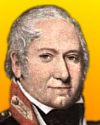 (source)
(source)
|
Henry Shrapnel
(3 Jun 1761 - 13 Mar 1842)
English soldier and inventor of the Shrapnel shell and other munitions improvements.
|
The Invention and Development of the Shrapnel Shell
from Field Artillery Journal (1920) *
by A. Marshall, P.I.C., (Chemical Inspector, Indian Ordnance Department)
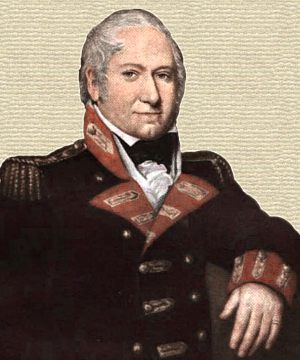
Lieutenant-Colonel, Royal Regiment of Artillery
Inventor of the “Shrapnel” shell
died lieutenant-general - 13 march, 1842
From an oil painting in the Royal Artillery Institution, Woolwich
(Painted by F. Arrowsmith, in 1812) (source)
[p.12] Shrapnel shell differs from other shell in that it is filled with bullets and contains a bursting charge which is only just sufficient to open it and allow the bullets to continue to travel along paths not diverging very much from the trajectory of the shell before bursting. Its effective use, therefore, requires the provision of a reliable time fuze. Although the claim was at one time disputed in favor of various French and German artillerists, there is no doubt that it was entirely the invention of Lieutenant Henry Shrapnel in 1784. The claim was fully established in a paper contributed in 1863 to the Proceedings of the Royal Artillery Institution by Captain Vivian Dering Majendie, R.A., at that time Captain Instructor in the Royal Laboratory and afterwards Sir V. D. Majendie, the first wholetime Inspector of Explosives.
Henry Shrapnel was born in 1761 at Midway Manor House, the old family residence not far from Winkfield in Wiltshire. He was the youngest of several sons, but as his brothers died without issue he became the head of the family. Otherwise, it is improbable that he would have had the means to establish his invention. He entered the army in 1779 as a Second-Lieutenant in the Royal Artillery, and after serving in Newfoundland and other places abroad returned to England in 1784 and began to investigate and experiment at his own expense on the various problems connected with hollow spherical projectiles filled with bullets and bursting charges, and with their discharge from the heavy and light ordnance of the time. In 1785 the principal features of the invention had been worked out, but its value was [p.13] not recognized by the authorities, and he was sent to Gibraltar for four years and then to the West Indies. He afterwards, in 1793, served with the Duke of York in Flanders and was wounded at the unsuccessful siege of Dunkirk. During the retreat Shrapnel’s originality came into play, for he suggested that the wheels of the gun-carriages should be locked and the guns skidded over the sands instead of being wheeled. This was done with conspicuous success.
For more than twenty years Shrapnel continued to devote all his spare time and a large part of his private fortune to perfecting his invention and bringing it to the notice of the authorities. In 1803 extensive trials were carried out at Government expense under Major Shrapnel’s directions and there is a copy of a letter extant from the Carron Company a year later requesting payment of some thousands of pounds for spherical case shot sent by them to Dublin, Leith and other places and for experiments carried out by Major Shrapnel at Carron. In the next year the shell was definitely adopted by the Board of Ordnance, and Shrapnel was appointed Inspector of Artillery at Woolwich and promoted to Lieutenant-Colonel. Shortly afterwards it was used with success in the attack on Surinam on the coast of South America, and at the battles of Rolica and Vimiera in Portugal. The troubles in connection with the fuzes had been overcome to a great extent, and the shell was used largely during the Peninsular War. The Duke of Wellington wrote to Sir John Sinclair in 1808 testifying to the great benefit which the army had derived from Shrapnel’s case shot in the encounters with the enemy. He considered it most undesirable that the invention should be made public, but as the inventor would thus be deprived of the fame and honor which he might otherwise have enjoyed, he should be rewarded amply for his ingenuity and science.
It would not seem that any adequate reward was ever paid, however, for in the extracts of the Ordnance Select Committee under the date 2nd June, 1852, there is the following entry: “Report of the Committee on Mr. Shrapnel’s letter of the 17th [p.14] May, 1852, requesting on behalf of the family of the late General Shrapnel of the Royal Artillery, the honour of the Board issuing an order that the spherical case shot be called shrapnel shells instead of spherical case by some and shrapnel shells by others, from the circumstance that other nations have long since done this honour of invariably attaching his name to this weapon, and because the family have not the means to afford the expense of erecting a monument awarded to the graves of other distinguished officers, but which such a distinction would be the means of representing.
“The Committee see no objection to this application of Mr. Shrapnel, and solicit your Lordship’s authority for his request being granted.” The original name, which had been used by Shrapnel himself was thereafter dropped and the shell has since been called invariably by the name of the inventor.
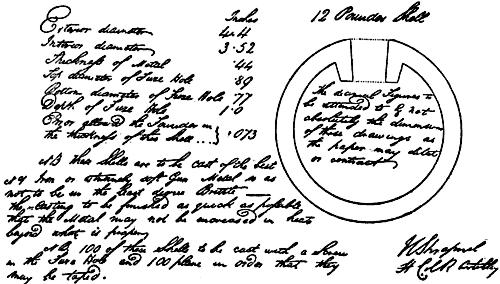
From Ministry of Munitions Journal, May 1917
The nature of the original shrapnel shell is shown in Fig. 1, which is a reproduction of a drawing and directions supplied by Colonel Shrapnel to the Carron Company for casting twelve-pounder shells. It will be seen that he laid down definite dimensions and limits. Similar instructions were provided for three- and six-pounder shells. The interior was filled with a mixture of bullets and powder and a time fuze was inserted into the fuze hole. The bullets were driven in tightly and then a few were removed near the fuze hole to make room for the bursting charge, which was not separated in any way from the bullets.
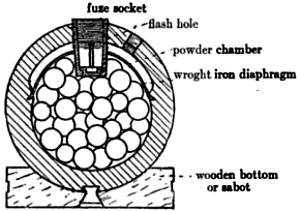
About the middle of the last century the occurrence of numerous prematures and blinds led to modifications of the shell. The blinds were due to faulty fuzes and diminished in number when these were improved, but the principal cause of the prematures was found to be the ignition of the bursting charge by the impact or friction of the bullets. On the Continent the balls were consequently fixed by means of sulphur, pitch, plater-of-Paris or other material. Captain Boxer, R.A., Superintendent of the Royal Laboratories, considered, however, that it was advisable also to separate the charge from the bullets. First, in 1849, the bursting charge was enclosed in a [p.15] canvas bag, but this arrangement was improved upon by substituting a tin cylinder. This stopped the prematures, but was not considered satisfactory by Boxer because the concentration of the powder in the centre of the shell caused too great a dispersion of the bullets; the angle of opening was too wide. He, therefore, in May, 1852, proposed the curved wrought-iron [p.16] diaphragm shown in Fig. 2. In order to prevent the shell operating at the place where the diaphragm meets it, it was made extra strong there and grooves were cast in the interior surface of the shell to facilitate the opening. The bullets were embedded in resin (rosin) which was found to be better than the other materials that had been used on the Continent, as these did not pulverize sufficiently. Trials with these diaphragm shrapnel were eminently satisfactory in 1852 and 1853, as they were found to be more accurate as well as superior in other respects. During the Crimean War (1854-6) large quantities were made, but as the design had not been worked out fully and inspection was evidently weak, many of these were afterwards found to be faulty. Further experiments led to the provisional approval of a design in December, 1858, and the manufacture of the old-pattern shrapnel ceased. In 1863 the Ordnance Select Committee called for reports from the various artillery stations at home and abroad. The great majority of these were very favorable, but the O.C. Devonport was apparently an extreme conservative, for he said: “The invention appears to be an instance where individual ingenuity has been suffered to exert itself in complication, costly, and cumbrous to Artillery service.” The Committee did not succeed in getting any report at all from India. Diaphragm shrapnel was definitely approved in September, 1864, but by that time rifled ordnance was coming [p.17] into use and spherical projectiles of all sorts were consequently becoming obsolete.
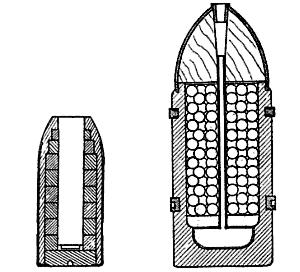
fig 4. (r) —armstrong's r.b.l. segment shell.
In 1858 rifled cannon were introduced on the recommendation of a special committee, and in the following year the segment shell was adopted on the proposal of Sir W. Armstrong for use in these guns against personnel. The construction of this shell is shown in Fig. 3. It consisted of a thin cast-iron jacket inside which were rows of cast-iron segments so arranged as to assist in withstanding the pressure from the outside. Lead was allowed to flow between them to help hold them in position, and the base, through which the segments were inserted, was also retained by lead. The outside was coated also with the same [p.18] metal, which was made to adhere more thoroughly by first treating the iron with zinc. This lead coating was applied to all the breech-loading projectiles of that period to enable them to take the rifling; there was a cannelure a little way up the shell into which could flow the lead displaced from further forward. The bursting charge of these shells was considerably greater than that of the shrapnel. It was fired by means of a rapid percussion fuze, but there was often a time fuze in addition.
Lieutenant-Colonel Boxer, in 1864, brought forward designs for a shrapnel shell for use in rifled ordnance, and this, which embodied all the essential features of the modern shrapnel, proved very satisfactory. After a time it entirely displaced the segment shell which indeed is compromise between shrapnel and common shell not possessing the full advantages of either. The shell illustrated is provided with studs for use with muzzle-loading rifled guns. The small powder chamber is in the base, the powder itself being contained in a tin cup. Resting on the lip of the powder chamber is a loose wrought-iron diaphragm with a hole in the centre into which passes a wrought-iron tube to convey the flash from the fuze to the bursting charge. Above the diaphragm are the bullets embedded in rosin. The ogival head is only lightly fixed to the body of the shell and is filled in with a block of wood.
It was no doubt due to his thorough study of spherical shrapnel that enabled Boxer to lay down once for all the essential features of the ogival shrapnel for rifled ordnance. Subsequent improvements have been confined to minor details, and the greater accuracy of the modern time fuze has greatly increased the effectiveness. During the present century the Germans have endeavored to introduce a high-explosive shrapnel (Einheitgeschoss), which had a charge of T.N.T. either in the head or amongst the bullets instead of rosin, the object being to have a single shell which could be used either as H.E. or shrapnel, but the great expense and the complication, especially of the fuze, caused them to drop it during the war. The shrapnel shell, therefore, remains an entirely British invention.
- 3 Jun - short biography, births, deaths and events on date of Shrapnel's birth.
- Henry Shrapnel - Short Biography
- Shrapnel shell construction - a history of its development.




